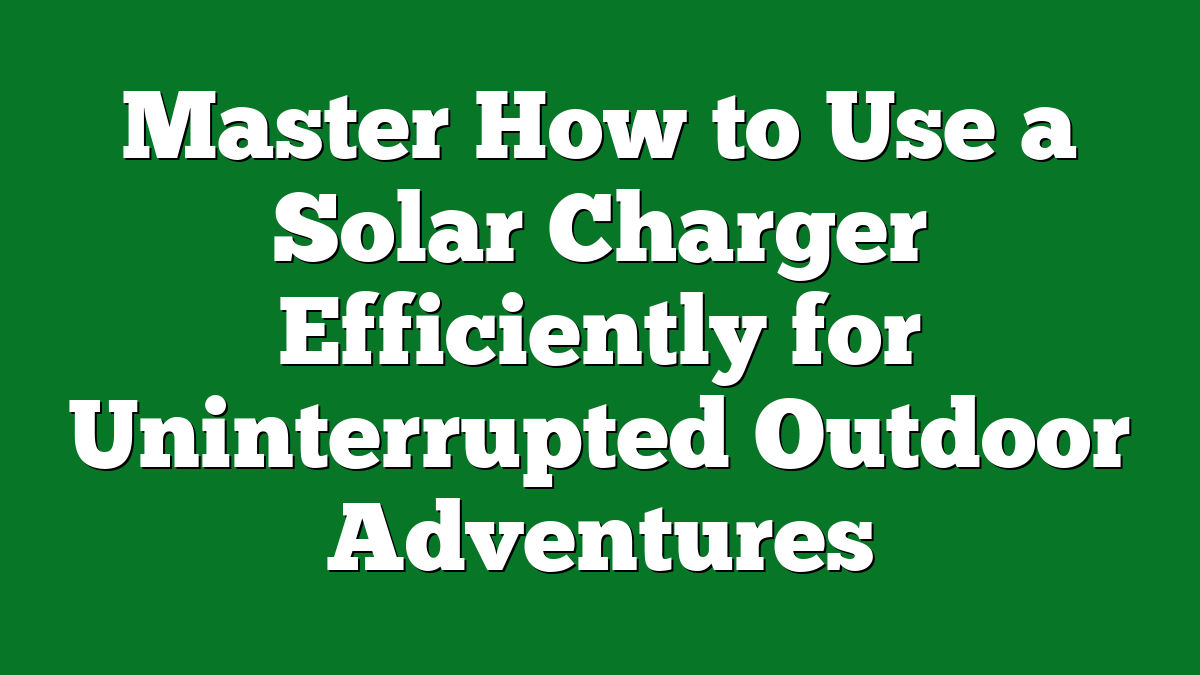Imagine basking in the sun while your devices charge up without a single outlet in sight. That’s the beauty of solar chargers. As someone who loves the great outdoors, I’ve found these handy gadgets to be game-changers for camping trips or beach days. But using them efficiently can make all the difference in keeping my devices powered up when I need them most.
Understanding Solar Chargers
Solar chargers are fantastic tools for powering devices while enjoying the great outdoors. They harness sunlight, providing a reliable energy source during my camping trips, hikes, or any outdoor excursions.
What Is a Solar Charger?
A solar charger converts sunlight into electrical energy, allowing me to recharge batteries and devices like smartphones, tablets, and cameras. These chargers typically comprise solar panels that capture sunlight and convert it into usable electricity. It’s not just about convenience; it’s about staying connected and capturing memories without worrying about drained batteries.
Types of Solar Chargers
- Solar Power Banks
Solar power banks store energy generated by solar panels. I often use them to charge multiple devices on the go. They’re portable, lightweight, and come in various capacities.
- Folding Solar Panels
Folding solar panels are compact, easy to carry, and ideal for camping. I can set them up in direct sunlight during the day, providing a steady charge for my equipment.
- Solar Backpacks
Solar backpacks integrate solar panels into the design, allowing me to charge devices while hiking. I appreciate the convenience of carrying my gear and charging my devices simultaneously.
- Solar Phone Chargers
Portable solar phone chargers are designed specifically for smartphones. Their convenience shines when I’m deep in the woods and need to make a call or check the weather.
- Solar Lanterns
Solar lanterns serve dual purposes—providing light and charging devices. They’re a great option for night hikes or camping, as I can keep my surroundings lit while ensuring my devices stay powered.
Embracing solar chargers adds an essential layer of convenience and sustainability to my outdoor adventures, making sure I’m always ready for whatever the wild throws my way.
Tips for Efficient Use
Using a solar charger efficiently enhances my camping experience, allowing me to stay powered up outdoors. I follow these practical tips to maximize the benefits of my solar charger.
Positioning Your Solar Charger
Positioning your solar charger properly is crucial. Place it in direct sunlight without any obstructions. I usually secure mine on the roof of my tent or on a flat rock where it can soak up the sun all day. Make sure to adjust its angle as the sun moves across the sky. The more sunlight it captures, the faster my devices charge.
Optimal Weather Conditions
Optimal weather conditions boost solar charging efficiency. Sunny days provide the best results, while cloudy weather reduces charging speed. I’ve found that early afternoon is the prime time for charging, as sunlight is at its peak. When conditions aren’t ideal, I plan shorter charging sessions and consider using a backup power source, just in case.
Maintenance for Longevity
Maintaining a solar charger ensures it lasts through countless camping trips. Simple upkeep can maximize performance and efficiency in the long run.
Cleaning Your Solar Charger
Cleaning your solar charger regularly keeps it performing at its best. Dirt, dust, and debris can block sunlight absorption. I use a soft cloth or sponge with mild soap and water to wipe down the solar panels. I’ve found that rinsing them with clean water helps remove any soap residue. Always let it dry completely before packing it away.
Storage Tips for Solar Chargers
Proper storage prevents damage and extends your solar charger’s life. I store mine in a cool, dry place away from direct sunlight when not in use. If camping gear gets wet, I ensure everything is dry before packing it to avoid mold or mildew. Keeping the charger in a protective case or pouch also prevents scratches and impacts during transport.
Common Mistakes to Avoid
I’ve learned that using a solar charger efficiently involves avoiding some common pitfalls that can limit its effectiveness during camping trips.
Overcharging Your Devices
Overcharging can damage your devices, reducing battery life. I always monitor my devices while they’re charging. Once they reach 100%, I disconnect them right away. Many modern devices have built-in protections, but it’s best to be cautious, especially when relying on solar power. Checking device indicators helps me stay ahead of the game.
Neglecting Regular Check-Ups
Regular check-ups on my solar charger ensure it’s always ready for use. I inspect connections and panels often. Dirt or grime can prevent solar panels from absorbing sunlight effectively, so I clean them with a soft cloth. I also look for any signs of wear and tear. By keeping everything in top shape, I maximize performance and enjoy uninterrupted charging during my outdoor adventures.
Conclusion
Using a solar charger can really enhance your outdoor adventures. With just a bit of attention to detail you can keep your devices powered up and ready to capture every moment. By positioning your charger in the right spot and keeping an eye on the weather you’ll maximize its efficiency.
I’ve found that taking care of your solar charger is just as important. Regular cleaning and proper storage can go a long way in ensuring it lasts for many trips to come. Avoiding common mistakes like overcharging will keep your devices happy too.
Embracing solar technology not only keeps you connected but also supports a greener lifestyle. So next time you head outdoors don’t forget to pack your solar charger and enjoy the freedom it brings.











